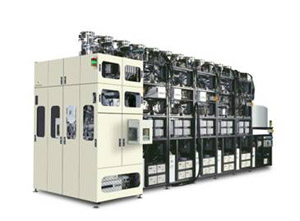XsunX is combining its thin-film photovoltaic (TFPV) process knowledge and processes with magnetic media thin-film manufacturing technologies used by the hard disc drive industry to mass produce high efficiency, low cost solar cells. Current techniques for the production of CIGS thin-films do not leverage stationary small area, high rate, production technologies which allow for the precise control of thin-film properties.
Interview - Using Hard Disk Technology to Manufacture Solar Cells
Tom Djokovich | XsunX, Inc
 Why did you recently change your business model?
Why did you recently change your business model?After review and vetting of our proposed adaptation of small area CIGS cell fabrication techniques to hard disc media manufacturing systems, we determined that this new hybrid manufacturing approach was superior to the systems we had developed for amorphous manufacturing. We elected to forego further investment into the amorphous systems and to focus on the development of what we believe to be a superior process and product.
How did you come up with this idea?
The idea was proposed by members of our scientific advisory panel with commercial hard disc media experience and staff with CIGS thin-film development and commercial production experience.
What is it that you’re doing, and what makes it unique?
XsunX is combining its thin-film photovoltaic (TFPV) process knowledge and processes with magnetic media thin-film manufacturing technologies used by the hard disc drive industry to mass produce high efficiency, low cost solar cells.
Current techniques for the production of CIGS thin-films do not leverage stationary small area, high rate, production technologies which allow for the precise control of thin-film properties. What makes our approach unique is the size of the solar cell. Unlike traditional manufacturing methods that scale the size of the deposition areas to several meters, our approach keeps the size of the solar cell small, initially about 5 inch by five inch wafers. We believe this will reduce the amount of processing defects which can lead to better cell performance while at the same time introduce a manufacturing method that can compensate for the individual small-area wafer processing with high throughput manufacturing techniques. Hard disk drive manufacturing equipment will allow us to keep the processing area small, as it’s already calibrated to the sizes we need.
How exactly do you combine the HDD industry with process knowledge from the CIGS and thin-films industry? Why?
We are working jointly with our HDD equipment partner, Intevac Inc., to create a unique and proprietary process of coupling small area deposition (approximately 5x5 inch squares), material control and material transport technologies from the disk drive industry for the use in the production of thin-film CIGS solar cells. While this combination of processes are unique and proprietary this is not new science but rather the coupling of better engineering and processes to create a more efficient manufacturing method.
 copy.jpg) Our chief technology officer, Mr. Robert Wendt, has more than 15 years experience in thin-film solar technologies and has worked with NREL researchers developing and testing different CIGS deposition methods. The combination of these two industries is currently being developed by Mr. Wendt who has mapped out a several stage process. For example, in September XsunX announced their goal was to begin testing the design of a thermal evaporation source for its suitability in manufacturing the core CIGS sun absorber. In October, we achieved that goal and had begun evaporating metal, analyzing results, and establishing deposition rates for both the evaporation source and sputtering tools. There are a number layers to the CIGS structure and for the next several months our work effort will be to analyze results and refine designs, with the goal of combining these designs within a tool set and the ability to deposit CIGS devices.
Our chief technology officer, Mr. Robert Wendt, has more than 15 years experience in thin-film solar technologies and has worked with NREL researchers developing and testing different CIGS deposition methods. The combination of these two industries is currently being developed by Mr. Wendt who has mapped out a several stage process. For example, in September XsunX announced their goal was to begin testing the design of a thermal evaporation source for its suitability in manufacturing the core CIGS sun absorber. In October, we achieved that goal and had begun evaporating metal, analyzing results, and establishing deposition rates for both the evaporation source and sputtering tools. There are a number layers to the CIGS structure and for the next several months our work effort will be to analyze results and refine designs, with the goal of combining these designs within a tool set and the ability to deposit CIGS devices.  Who are you partnering with in the HDD industry to bring this technology to commercialization?
Who are you partnering with in the HDD industry to bring this technology to commercialization?We have announced our business development relationship with Intevac, Inc., an established equipment supplier to the hard disc drive industry. With this relationship, we have access to extensive equipment and engineering resources to assist in the manufacturing technology development.
What market applications do these types of solar cells have?
Currently, over 80% of the solar market uses silicon wafers to manufacture solar modules. We believe that by making a thin-film CIGS wafer on a stainless steel substrate we may be able to provide or produce an alternative technology to silicon. The thin-film CIGS wafer would be used as a substitute to silicon wafers in the assembly process of a solar module. Additional market applications include: utility scale solar fields; BIPV products; residential markets; and consumer products.
What gives this approach to solar cells a competitive edge over other innovations?
This approach is a technology that bridges the gap between inexpensive thin-film and high efficiency silicon wafer technologies to produce solar cells for multiple market segments and a wide variety of applications. We are essentially taking proven science and manufacturing methods and combining these to produce a product that reduces the structure defects caused by large area processing techniques. This, in turn, produces higher conversion efficiencies, and utilizing high-rate material processing techniques from the HDD industry to then compensate for the needed volume under commercial production. The result are manufacturing systems that require significantly less space, cost less per MW, provide proven commercial production cycle uptime, and produce a CIGS solar cell that provides conversion efficiencies approaching that of polysilicon at about ½ the cost.
What special manufacturing processes are required to build the cells?
XsunX is engineering small and highly efficient sputtering process combined with a thermal evaporation technique. Each system houses multiple processes zones allowing for simultaneous and continuous processing to achieve production volumes.
Using sputtering technologies alone, it is possible to manufacture all of the layers necessary to make a CIGS device. However, industry research has shown that sputtering alone has not achieved the same efficiency milestones that have been achieved when sputtering is used in combination with evaporation techniques to make the CIGS device. Evaporation requires less processing time and in the long run provides a more efficient use of less costly materials.
The difference in efficiencies between sputtering and evaporation can be significant. This is what our chief technologist, Robert Wendt, learned in his many years working with CIGS.
When do you expect to bring these solar cells to market?
We gave a two-phase plan that starts with building a full scale working GIGS cell and ends in late 2010 with the completion of a small pilot production facility for use in continuous process improvement and marketing of our JV manufacturing licenses.
With market timing in mind, which market applications do you expect to be the first to adopt this technology?
We believe the replacement of silicon wafers will be the first application where our technology is adopted. Replacing existing costly silicon wafers is a vast market opportunity to replace aging technology.
The content & opinions in this article are the author’s and do not necessarily represent the views of AltEnergyMag
Comments (0)
This post does not have any comments. Be the first to leave a comment below.
Featured Product
OMCO Origin® Factory-Direct Trackers
A One-In-Portrait (1P) solution that support a wide range of solar projects (utility scale, distributed generation (DG), & C&I markets). Manufactured and factory preassembled in the USA at one of OMCO Solar's 5 US plants (AZ, IN, AL, OH), OMCO makes all structural components with domestic steel and now can offer a 100% domestic tracker. OMCO Origin® Factory-Direct Trackers include universal module mounts with options for all commercially available modules, labor-saving bearings with 6 adjustable ways to compensate for posts and terrain issues, and foundation solutions for every terrain including OMCO C Piles.
